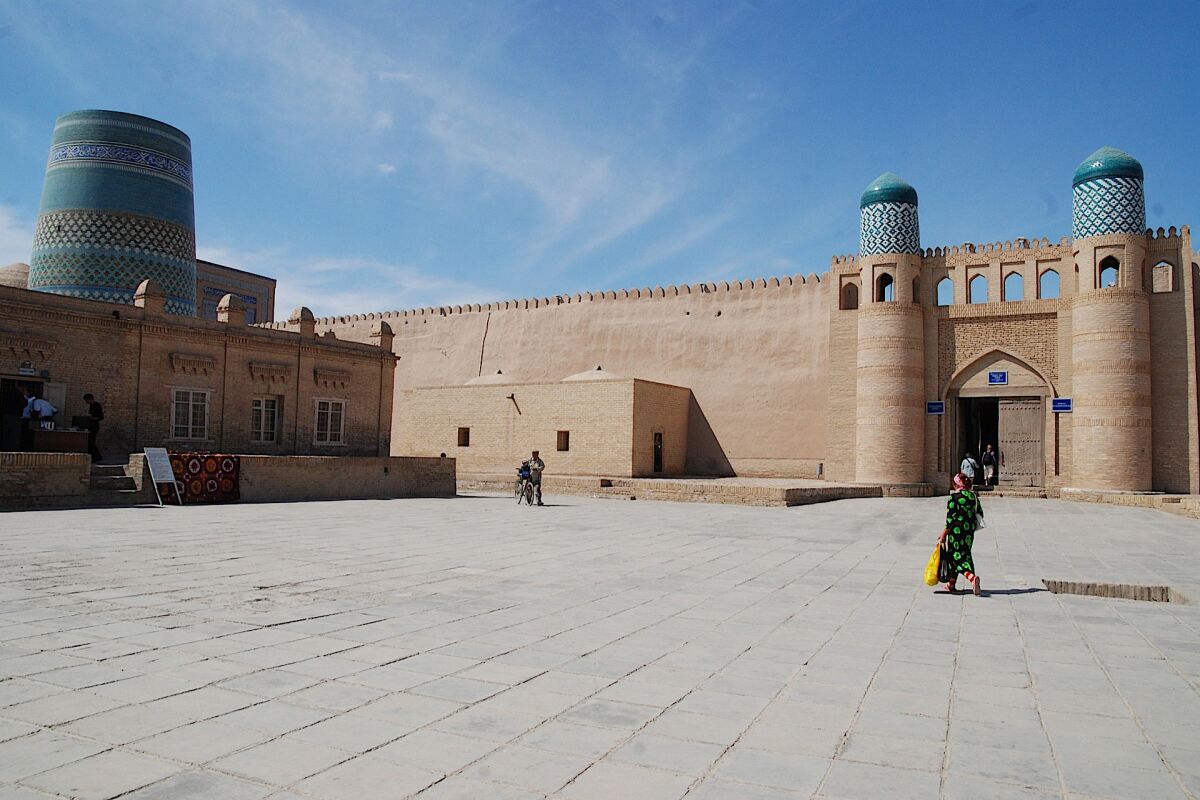Khiva - Garden in Dishan Kala

The Garden in Dishan Kala of Khiva: A masterpiece of Central Asian horticulture
The garden in Dishan Kala of Khiva was an impressive complex that stood out not only for its architectural design, but also for its agricultural diversity and cultural significance. Encompassing the outer city walls of Khiva, Dishan Kala was home to this magnificent garden, which was divided into different sections and served as an oasis of tranquillity, political power and social life.
Structure and architectural features
The garden complex consisted of several separate courtyards separated by high earthen walls. Within these walls were a reception room, a recreation courtyard, a Harem* and various service buildings. The design of this complex followed the traditional principles of Central Asian horticulture, in which architecture and nature merged harmoniously.
A central feature of the gardens were the havuze, large water basins that were present in both the male and female halves of the courtyard. These basins played a crucial role in regulating the microclimate and watering the gardens. Along the banks of these havuze stretched picturesque pergolas and extensive aiwans, large covered terraces that served as shady retreats for the inhabitants. The garden paths and courtyards were planted with hujums, spherical elms, which provided additional shade and decorated the surroundings with their dense foliage.
Diversity of vegetation and agricultural importance
The garden complex of Dishan Kala was not only a place of recreation, but also a centre of agricultural excellence. Numerous varieties of fruit that were characteristic of the region thrived here. These included various types of grapes, apples, pears, plums, figs, pomegranates and peaches. The abundance of these fruits testifies to the highly developed art of horticulture in Khiva, which was made possible by sophisticated irrigation systems. The use of centuries-old canal systems, known as aryks, ensured a constant supply of water, which made successful cultivation possible.
The private gardens of the heirs to the throne and high-ranking officials of the Khanate were located directly around this garden complex. These feudal gardens were designed according to similar principles and contributed to the aesthetic and economic importance of the entire district. Most of these gardens were created during the reign of Allakuli-Khan (1825-1842), who was known for his ambitious building and urban development projects.
Political and cultural role of the garden
At the beginning of the 20th century, the Nurullabay garden in Dishan Kala developed into a central political and administrative centre of Khiva. Important facilities such as the divans, the administration of the khanate, the guardhouse and the Harem* of Isfandiyar Khan were located in the centre of this garden landscape. These buildings formed the heart of the city’s political life and served as meeting places for high-ranking dignitaries and officials.
However, the garden in Dishan Kala was not only a centre of political power, but also an important venue for cultural gatherings and social events. Music and dance performances, poetry evenings and religious celebrations took place in the magnificent aiwans and characterised the social life of the city.
Decline and loss of a historical heritage
The Russian conquest of Central Asia and the political upheavals that followed, in particular the October Revolution of 1917, brought about a profound change in the urban landscape of Khiva. Many of the ornate gardens and palaces were destroyed or misappropriated. The once magnificent gardens that had characterised the cityscape of Khiva for centuries gradually disappeared.
Industrialisation and urban change led to traditional gardens and irrigation systems being neglected or replaced by modern buildings. As a result, an important architectural and cultural heritage that once reflected the identity and splendour of the city of Khiva was lost.
The garden in Dishan Kala was an outstanding example of the central role that horticulture played in the urban design and social life of Khiva. As part of a centuries-old tradition, it combined architectural elegance with agricultural sophistication and political significance. Even though many of these historic gardens no longer exist, their memory remains as a testimony to a bygone era. Today, the few remaining gardens in Khiva are memorials to the former splendour of this city and a reminder of its great history.
*Harem (Arabic: حريم ḥarīm, “a sacred inviolable place; harem; female members of the family”) properly refers to domestic spaces that are reserved for the women of the house in a Muslim family. This private space has been traditionally understood as serving the purposes of maintaining the modesty, privilege, and protection of women. A harem may house a man’s wife or wives, their pre-pubescent male children, unmarried daughters, female domestic workers, and other unmarried female relatives. In royal harems of the past, concubines of the prince were also housed in the harem (Source: Wikipedia).
